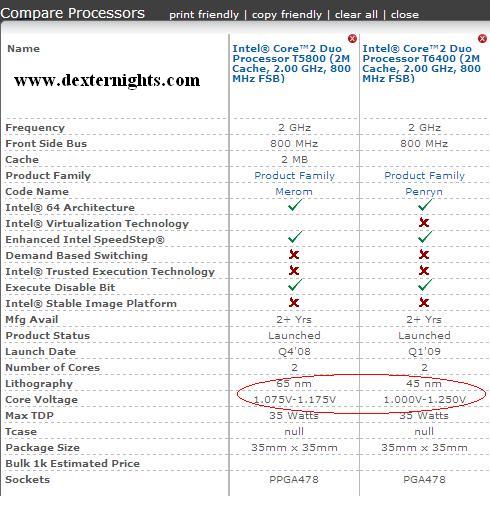|
Name |
Intel® Core™2 Quad Processor Q8200 (4M Cache, 2.33 GHz, 1333 MHz FSB) |
Intel® Core™2 Quad Processor Q9550 (12M Cache, 2.83 GHz, 1333 MHz FSB) |
Intel® Core™2 Quad Processor Q9400 (6M Cache, 2.66 GHz, 1333 MHz FSB) |
|
|
Status |
Launched |
Launched |
Launched |
|
|
Launch Date |
Q3’08 |
Q1’08 |
Q3’08 |
|
|
Embedded |
N |
N |
Y |
|
|
Supplemental SKU |
N |
N |
N |
|
|
Lithography |
45 nm |
45 nm |
45 nm |
|
|
Max TDP |
95 W |
95 W |
95 W |
|
|
1ku Bulk Budgetary Price |
$163.00 |
$266.00 |
$213.00 |
|
|
Processor Number |
Q8200 |
Q9550 |
Q9400 |
|
|
# of Cores |
4 |
4 |
4 |
|
|
Clock Speed |
2.33 GHz |
2.83 GHz |
2.66 GHz |
|
|
Cache |
4 MB L2 Cache |
12 MB L2 Cache |
6 MB L2 Cache |
|
|
Bus Type |
FSB |
FSB |
FSB |
|
|
System Bus |
1333 MHz |
1333 MHz |
1333 MHz |
|
|
Instruction Set |
64-bit |
64-bit |
64-bit |
|
|
Core Voltage |
0.8625V-1.237V |
|
0.850v – 1.3625v |
|
|
Intel® Demand Based Switching |
N |
N |
N |
|
|
Intel® Dynamic Speed Technology |
N |
N |
N |
|
|
Intel® 64 |
Y |
Y |
Y |
|
|
Execute Disable Bit |
Y |
Y |
Y |
|
|
Halt State |
|
Y |
N |
|
|
Intel® Hyper-Threading Technology |
N |
N |
N |
|
|
Enhanced Intel® Speedstep Technology |
Y |
Y |
Y |
|
|
Intel® Trusted Execution Technology |
N |
Y |
Y |
|
|
Intel® VT-x |
N |
Y |
Y |
|
|
Package Specifications |
||||
|
Tcase |
71.4°C |
71.4°C |
71.4°C |
|
|
Package Size |
37.5mm x 37.5mm |
37.5mm x 37.5mm |
37.5mm x 37.5mm |
|
|
Die Size |
164 mm2 |
214 mm2 |
164 mm2 |
|
|
# of Transistors |
456 million |
820 million |
456 million |
|
|
FSB Parity |
N |
Y |
N |
|
|
Sockets Supported |
LGA775 |
LGA775 |
LGA775 |
|
|
Halogen Free Options Available |
Y |
Y |
Y |
|
The three processors Intel® Core™2 Quad Processor Q8200, Q9400 and Q9550, are the three options most Desktop buyers would be looking to choose between (Sorry for the AMD users, we will come back to AMD comparison soon) if they are looking for Quad Cores. All these processors have four cores and are in the entry to mid level of the Quad Core segment (All in premium end of overall processors). Price wise all of them fall in medium to premium segment costing between $150-$260 on their own ( Rs 9000.00 to Rs 15000.00 INR )
The highlights of these three processors are they all follow 45nm architecture, 95W power consumption and all are supported in LGA775 socket. So you can choose your motherboard and decide between these three procesors. All these processors use 1333 MHZ System Bus.
The main difference is the processor speed at 2.33GHZ, 2.66GHz and 2.83 GHz respectively which isn’t a big difference for the cost. Other significant difference in terms of technical details is the Cache which is 4MB L2, 6MB L2 and 12 MB L2 for processors Intel® Core 2 Quad Processor Q8200, Q9400 and Q9550 respectively. But the performance improvement of the increased cache can be hardly felt as most hardware experts say beyond 2MB L2 cache the difference in performance is minimal.
When we check the performance of the processor as per CPU benchmark results the results are very much progressive.
See the price vs performance ratio of the Quad Core desktop processors here.
